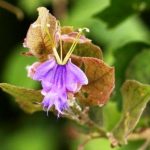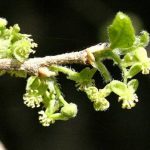TREE LIFE
MAY 1996.
Subs ($40) for the year 1996/97 were due on 1st April.
MASHONALAND CALENDAR
Tuesday 7th May. Botanic Garden Walk at 4.45 for 5 p.m. We will meet Tom in the public car park of the Gardens, and continue with Burseraceae –Commiphora. There will be a guard for the cars.
Sunday 19th May. The AGM and monthly walk will take place at Mhowani Hills Farm, Teviotdale by kind favour of the owners and Ken and Sue Worsley. We will meet at 9 a.m. for tea and the meeting will start at 10 a.m. After the meeting and before lunch we will start our usual walk. Please bring your chair and a picnic lunch.
As in previous years, eats for the AGM tea will be most acceptable.
Saturday 25th May. Mark’s Walk. Please phone 745263 for venue and time.
Saturday 1st June. Botanic Garden Walk. Please note the switch to Saturday morning during the winter months.
The proposed trip to Cape Town later this year is cancelled. It is just not possible this year.
MATABELELAND CALENDAR
Sunday 5th May. All day visit to Malilangwe, Richard Peek’s property near Marula. Erythrophysa transvaalensis is found here. Meet at Girls’ College for a prompt 8.30 a.m. departure.
Sunday 2nd June. All day or half-day according to preference – Leopard Rock kopjie area, Khami River.
CHAIRMAN’S REPORT 1995-1996.
The past year has been an exciting and interesting one for our Society. I will recall just some of the changes and highlights that occurred during the last 12 months.
But first, our mentors, starting with Tom Muller who has lead our monthly Botanic Garden Walks for counting up to, is it 24 years? Tom must have covered each tree a dozen times or more, with the humour and comments that have made the walks so enjoyable and it is at these times that our learning curve is at its greatest. Thank you Tom for showing us the finer points of so many different species. With the award of an Honorary Doctorate last year, will we now have to respectfully address you as Dr?
Though we don’t see Bob Drummond as much as we did, piles of plants pressed, and in varying stages of decay, find their way under his botanical eyes for identification, the more decomposed the greater the challenge! Thank you Bob very much for the advice and time which you give so freely.
Mark Hyde continues to lead and teach us on his monthly Botanic Interest Walks, and like Tom has endless patience.
As reported in Tree Life No.193, the Committee of the Bulawayo Branch will change with the resignation of Ian McCausland as Chairman and of Sharon Brennan and Margaret McCausland. On behalf of the Society may I take this opportunity to express our most grateful thanks to Ian for his hard work, enthusiasm and his loyalty to the Society over the past few years. Thank you for your huge contribution Ian.
We offer our best wishes to Sharon on her forthcoming marriage.
Fortunately the past year brought with it a better rainy season than has been the norm for some years and the recovering vegetation was a delight to see on our outings during and after the rains.
The Committee of the Bulawayo Branch organised some really interesting outings for their members. It was a pity we could not join them to places such as the scenic Lumeni Falls which sounded like a superb spot, and Zindele Safaris for a weekend. However some of us made it for the wonderful trip to Kana Estates at Gwaai, where we reacquainted ourselves with Ricinodendron (now Schinziophyton) and Dialium. An addition to Bulawayo’s calendar was the screening of the fascinating video entitled The Private Lives of Plants, over 6 sessions, which were carefully spaced to avoid Botanic overload! Cold rather than icy conditions rerouted the Bulawayo’s group to Sandy Spruit in the Matopos in July, and August’s outing raised the Combretum collinum / Combretum zeyheri question once again. Coinciding with the first rains and the green flush was a visit to Woodleigh Farm.
For Harare members the return of the Haxen clan was welcomed at Ngomakurira in July. In August we paid another visit to M’torcha Mountain in the Mtoroshanga area to see the flowering Stereospermum kunthianum and Albizia tanganyicensis, as well as to confirm the existence of Pavetta eylesii – the first record of this species in the northern division. Some of the longer trips included two visits to Rifa in the Zambezi Valley, one in late May and another, more recently, in February/March, when the valley was a wonderful place at the height of the rains, and the only irritation was the hungry mosquitoes. Other outings we enjoyed were to the wonderful caves and paintings at Marussino Farm in Trelawney, Mazuri Ranch in the Kwekwe district for the May Day weekend and the Christmas function under thatch at Mbizi Game Park with a welcome downpour in the afternoon. In June we enjoyed a combined trip to the Palm Block with the Cycad Branch of the Aloe Society.
Other exciting events were the rediscovery of Protea asymmetrica in the mountainous area near Chingamwe Estates with Mary Clarke, Bob Drummond and Derek Archer in September; and the remarkable find of the Aardvark Cucumber, Cucumis humifructus near Gadzema in March.
The effects of tropical cyclone Bonita produced downpours such that our outing to Christon Bank in January had to be cancelled, the first cancellation in many years.
Our hosts are the key to our outings and we are very grateful to them for their hospitality.
A departure from indigenous tree walks, with a most interesting Eucalyptus walk with Lyn Mullin covering most of the species that have been planted in Harare, and a follow-up dealing with conifers. These walks opened our eyes to a completely new field and our thanks to Lyn for a fascinating study.
Orchids might seem rather ‘out of range’ for tree studies, however, with so many shared habitats they are an important part of the flora. Starting with a slide show in July, Werner and Virginia Fibeck then showed us Eulophia, Satyrium and Epiphytic species in the field. These sessions have been most interesting and we thank them both.
We are indeed fortunate that our members have a wide variety of interests and these were reflected in the informative articles carried in Tree Life.
Contributors once again kept the publication alive with interesting and varied articles. In particular, our thanks to Dickie Graves for her articles filled with interest and anecdotes of nature’s movements at Nyarupinda Catchment, Mark Hyde for keeping us on the botanical straight and narrow with his reports on the Botanic Garden walks. Lyn Mullin seems to have a limitless supply of interesting snippets of a botanical nature, often underlining the current topic. The editor of Tree Life is grateful to all who contribute so willingly.
A notable change came with the October edition of Tree Life when the publication went into high-tech. The result is a great improvement and we thank Bob Manser for doing the ground work. The original is now processed by Maureen on computer prior to photocopying. We thank Maureen for keeping the secretarial side of things organised in addition to maintaining the Tree Mapping project. As has been the practice for some time now, adhesive labels carry the addresses. Our thanks to Vida for collating and mailing Tree Life on time every month, and to Rose who has so ably managed our finances.Tree Society members have been extremely generous with their donations to the Botanic Garden Fencing Fund, and the initial target of $3000 has been reached. Any surplus will be held over for Phase Two. Thank you all, for your generous support.
I hope that during the last year you have enjoyed the outings. Even if the concept of Ten Trees learnt per trip was too tall an order, it is my continuing hope that a small part of the botany and ecology around us is made a little clearer each time.
My thanks to the members of both committees for keeping the Society running so well.
-Andrew MacNaughtan.
17th MARCH, 1996. EZINTABENI, GADZEMA AREA
For once Gadzema had had good rains, the bush was green, the grass thick, and our day got off to a fine start with a rare sighting, for many of us, of Carmine Bee-eaters on the power line at the Speight’s gate whilst we waited for the last cars to join the convoy. Then it was ‘pile into trucks’ and follow the winding route to Flat Rock No.2 – other favourite areas being ruled out as the roads go through mopane patches.
Ezintabeni – Place in the Hills, aptly named, has an abundance of interesting corners. As we stepped out of the trucks, the hills tumbling with rocks all round us, small flowers blessed our careful steps, and we were to see more. The bright yellow Bidens, a Barleria, white Leonotis, the creamy Dyschoriste, an orange Crassocephalum, and various other tiny pale blue jobs.
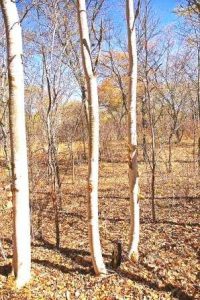
Albizia tanganyicensis. Photo: Meg Coates Palgrave. Source: Flora of Zimbabwe
And right before us, beautiful large Albizia tanganyicensis drew us forward – one with papery rusty peeling patches, another with peeled trunk gleaming soft pearl, and still in leaf. Brachystegia glaucescens nearby, the epitome of enduring grace, lightly shaded Margaritaria discoidea, its leaves more variable and softer than Erythroxylum emarginatum with which it may sometimes be confused. Catunaregam spinosa gave rise to a discussion on overgrazing – George remarked that its slow growth indicates that overgrazing probably occurs some 20 years or more before the density of a stand becomes noticeable. From there Vangueria infausta and large Kirkia acuminata lead us on to the theory (which I hope to use in school clubs) that long-ago folk-lore may have played a useful conservation role. An important fruit tree, Vangueria is not cut for firewood because it is believed to be unlucky. In some areas, Kirkia is considered sacred – George told of a belief that it had been the one tree to welcome Chaminuka when he first came to earth: and its swollen roots are a source of water in times of drought.
Other wild fruit trees seen were Flacourtia indica, so different from most others in its shape – its long arcuate branches, and lovely fall shades appeal to the landscapers’ eyes in most of us. And three members of the family Annonaceae, for whose fruit one must race the squirrels and birds. Hexalobus monopetalus which so often seems to grow snuggled up to some other, bigger species, its shiny dark green slightly obovate leaves already starting to show the discolourous spots which label it in winter.
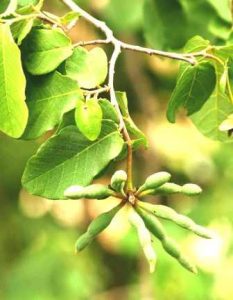
Friesodielsia obovata. Photo: Bart Wursten. Source: Flora of Zimbabwe
Friesodielsia obovata with larger, thinner and more clearly obovate leaves and Artabotrys brachypetalus which displayed, if we searched for them, the hooked, partly flattened flower/fruit peduncles which give rise to its name Hook-berry, also had some of the galls present which are typical of this plant. All three have edible, palatable fruit, and intriguingly, almost artificial-looking flowers.
Combretum apiculatum, with thinnish twisted drip-tips to its leaves, offered welcome shade, but a large Ficus abutilifolia drew us forward, its fairly large, thick, smooth leaves highlighted by the pale veins, but only a hint of pink in the petioles. Its roots were clasping and prizing apart the rock around which it grew. One would guess it to be an old tree, for even when pampered, this seems to grow very slowly. Having seen Strychnos spinosa on better soil, on the gravely rocky patches we found Strychnos innocua with smooth, slightly dusty trunk. And next to it Psydrax livida, with this season’s growth still green-green where it had not been browsed – and the Rubiaceae signature, the interpetiolar stipule, very clear.
After clambering halfway up another rocky kopjie to see the view over broken country towards the Mupfure River, we lunched in the shade of the Albizia, Commiphora mollis, Pouzolzia mixta, Euphorbia matabelensis and Commiphora mossambicensis, somehow surviving in thin-looking gravel and sand. Then ‘pile back into trucks’ for another twisty drive to a farm darn along the boundary, and quick, was that not Burkea africana, here, Boscia salicifolia there, Julbernardia globiflora and Brachystegia spiciformis every where? What a joy to see clear water running, and the children were soon cooling off; whilst we admired Afzelia quanzensis behind the darn wall, typically growing among rocks, and not far off, Ficus ingens with light grey trunk and roots oozing in and around another rock. A favourite tree, Mimusops zeyheri almost at the stream bed, pulled us on to gaze. in wonder at the richly-laden Antidesma venosum, its tassels of fruit still too pale, but soon to change to pink, red and black, a bush supermarket special for birds.
Some discussion arose over Terminalia trees, one almost certainly Terminalia stenostachya, with a few metres away another that looked more like Terminalia sericea but we wondered if it were not a hybrid, as it did not seem quite right! There were other Terminalia sericea however. Further down, in the stream bed a Syzygium guineense with a definite, but not very long petiole, we decided it could only be that. But to keep us puzzling, the young Ochna did not have as cracked and tessellated bark as we usually see in Ochna schweinfurthiana – we had noticed this with another small tree in the morning, so asked for a sample to be taken in to the Herbarium. On the opposite bank a Sterculia africana still carried some leaves, its trunk splotched dark pink-brown and cream. Near the vehicles and plentiful in other places were, Parinari curatellifolia, Monotes glaber with yellow-green leaves; Pseudolachnostylis maprouneifolia; and thickets of Dichrostachys cinerea on old lands, the puncture-maker supreme! Stubby looking Olax obtusifolia and graceful Olax dissitiflora with pendulous long-tipped leaves were seen near one another, the latter still stubbornly resistant to the crush, wait and then sniff test for cyanic acid smell. Also less well-known, was Diospyros squarrosa, one laden with green fruit – did anybody notice the calyx lobes bending backwards from the fruit? And on the way back to the farmhouse, the Acacia sieberiana, Acacia gerrardii, Acacia goetzei with fairly small leaflets and prickles on the rachis, Acacia polyacantha and Acacia amythethophylla. On the termite mounds Diospyros lycioides, Azanza garckeana, Capparis tomentosa combining to offer shelter to small animals, Diospyros kirkii fruit for the monkeys and Hornbills. And did anybody else notice the Stereospermum kunthianum near the large Albizia versicolor on the crest of the tobacco lands road? Last September the Stereospermum were a gentle haze of pink even in the heat, attracting bees by the score, and then too, the Albizia was dropping fresh green pods, so dangerous to cattle that it worries Graham to leave the tree untouched.
The Speight family has been in the area since 1906, the children being the fourth generation, and it is good to see the family treasuring the land and the ecosystem that is in their care. An uphill battle with droughts a-plenty, raging bush fires (imagine trying to control fires on Ezintabeni) and aggressive poachers. Thank you Graham and Margaret, for sharing this special bit of wild countryside with us – we shall be back someday!
-Ann Bianchi.
CHEGUTU OUTING: 17TH MARCH 1996.
It was expected that the visit to the Speight’s farm at Chegutu would be of botanical interest, and indeed, after such an excellent rainy season the herbaceous flora was in fine condition, although already beginning to dry out.
A number of specimens were collected and were kindly named (or confirmed) by Bob Drummond. Perhaps the most remarkable find was the Aardvark Cucumber, Cucumis humifructus. This extraordinary and, I believe, rare plant buries its fruit several inches underground. Maureen found the trailing stems and these look at a glance, like any other Cucurbit, except that all the fruiting stems disappear into the ground. Fortunately, what were believed to be Antbears had been digging up the fruit. We did the same and were rewarded by white, ± spherical bodies about 7 cm in diameter.
A recent article in Veld and Flora informs us that this is the only member of Cucurbitaceae known to bury its fruits (this feature is rare in all families). The fruits have a waterproof outer skin so that the seeds are not released until something (only the Antbear known to do this) digs them up and eats the fruit.
Olax obtusifolia was confirmed by Bob and was new (to my lists) for the Central Division. On all the published lists, It is only reported from the Northern Division. However, Ann Bianchi has seen it in the past at Dodhill. Another species new to the Central Division was Desmodium ospriostreblum, a purple-flowered herb with 3-foliolate leaves.
The climbing large-flowered pea, thought by me to be a Buffalo-bean (Mucuna sp.) was Eminia antennulifera which is quite closely related. The rather beautiful annual composite with purple bracts was Vernonia anthelmintica as we thought. Cheryl’s annual Euphorbia was Euphorbia tettensis.
New to me was Heteropogon melanocarpus, an annual grass of the same genus as Heteropogon contortus, the common and unpleasant spear grass.
Once again, thanks to Bob Drummond for naming the plants found.
-Mark Hyde
MATABELELAND BRANCH OUTING, 8TH April 1996
There are several places where the City of Bulawayo ceases quite unexpectedly. It is suddenly replaced by wonderful wild Africa. Such an area is upon the plateau that uses to the south of the city. Take the Old Esigodini Road. Proceed to the right on the Fortune’s Gate Road. Meander a little, negotiate a small pass and there you are, on Circular Drive. Civilisation is still represented by the tall PTC mast that rises abruptly from the bush. Indeed, glance beyond it, and the city can be glimpsed. But turn resolutely away on an excellent asphalt road and you are completely and firmly immersed in the countryside.
Here the Tree Society gathered for the Easter Monday outing. For the last few days the weather had been chilly, overcast and drizzly. And although on Easter Monday at dawn the sky was clear and the sun rose, a bank of cloud lifted off the Matopos Hills and drifted ominously over the city. The air-stream veered to the north, and the fluffy cumulonimbus spaced themselves out, allowing a warm, partly cloudy sunny day to continue.
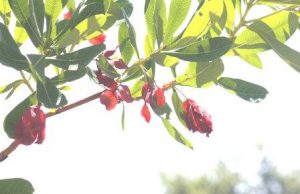
Terminalia brachystemma. Photo: Bart Wursten. Source: Flora of Zimbabwe
We turned off the highway on a rough track and parked in sight of an inviting kopjie. There was plenty to engage our attention. The Terminalia trees were well grown, some displaying the bright red seedpods of Terminalia brachystemma. But Terminalia sericea and Terminalia trichopoda were also there, along with many confusing hybrids, not easily identifiable. The Clerodendrum glabrum that months ago were so spectacularly in flower, were now heavy in fruit.
In past years, a local farmer rented this land from City Hall and one occasionally chanced upon his herd of humpy Brahman cattle, majestically making their way in single file. This day we did not meet them, but cattle were quite obviously still part of this landscape. The Fan Lilies – Boophone disticha, were all grazed and hoof prints bored deep into damp ground.
We converged around what for me was a completely new tree – Scolopia zeyheri.
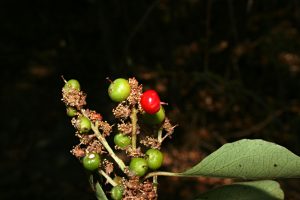
Scolopia zeyheri. Photo: Mark Hyde. Source: Flora of Zimbabwe.
It stood near a stately Euphorbia ingens, amid a small grove of what appeared to be its own root suckers. Viewed against the sky it made a very beautiful silhouette. The trunk and branches were gracefully gnarled, and it must be extremely old. I noticed that the suckers were all armed with vicious thorns, whilst the parent appeared to none. Jonathan explained that this is quite often the case with thorny trees. When young, they need protecting against potential browsers, but having succeeded in reaching maturity, the armour becomes redundant.
On the ground were numerous small clumps of the wild clover, Oxalis sp. Some sported attractive pink flowers. There was also a local Crassula wearing a long knobbly flower.
As we proceeded towards the alluring kopjie previously referred to, I observed the largest Ormocarpum trichocarpum I have ever seen. It must be well over fifteen feet high. I wonder whether it could be a record?
The wild ginger, Tetradenia brevispicata, and Lippia were everywhere, but not in flower, although frequently one could smell their fragrant leaves.
It is surprising that after such a good rainy season the land had dried out, and what patently should have been wet lands were already waterless and apparently lifeless. The Selaginella which a month ago was swollen and green had crept back into itself and was now grey and brittle, in the brown grass that matched the soil.
The lovely summer is slipping away. Autumn’s clasp is beginning to manifest itself and many Commiphora mollis are leafless, while some trees’ seeds are already dry. The sere and withered leaf is becoming apparent. Even the ever abundant butteries are now all yellow!
62 tree species and 20 shrubs and herbs were recorded.
-Norma Hughes.
Extracted from Wood Southern Africa & Timber Times. January 1996.
TREES OF THE YEAR FOR 1996.
This year two trees have been named “tree of the year”, the Kiggelaria africana or wild peach and the Warburgia salutaris or pepper-bark tree.
Pepper-bark tree.
The Warburgia salutaris or peperbasboom of the Canellaceae or cinnamon family has a very limited distribution ranging from northern KwaZulu/Natal, through Swaziland and Mpumalanga, to northern countries like Kenya and Uganda.
The family consists of five genera and 16 species in the Americas, Africa and Madagascar. Three of the species are in Africa and the pepper-bark tree is the only one found in SA.
It is a slender tree, five to ten meters tall, occurring in evergreen forests. The new blue-green leaves appear in February, after which the old leaves are dropped. The leaves are aromatic, elliptic to lanceolate, glossy dark above, paler green underneath.
The fruit is a spherical berry up to four centimetres in diameter, with a leathery black skin when ripe from October to January.
A sought-after medicinal tree, the inner bark is reddish, bitter and peppery and can be used to treat the common cold. Dried and ground to a snuff it clears the sinuses, and when it is chewed or the smoke from burning bark is inhaled, it eases chest complaints. Boiled in water with the roots, it is said to be effective against malaria.
The bark fetches a high price on the market and the demand for it has made it an endangered species.
Wild peach Kiggelaria africana
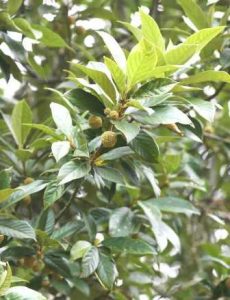
Kiggelaria africana. Photo: Bart Wursten. Source: Flora of Zimbabwe
The Kiggelar africanaia or wildeperske/speekhout is a popular evergreen garden shade tree. It grows four to 12 metres tall and up to 11 metres wide and attracts butterflies.
The leaves look very much like that of an ordinary peach tree and the round fruit is a favourite of birds like the grey hornbill, olive thrush, Cape thrush, Cape robin, white-eyes and shrikes.
The pink, semi-hardwood is suitable for making boards, rafters, agricultural tools and furniture. It is known as speekhout in Afrikaans because the wood was used as spikes for wagon wheels. The leaves provide a pink dye.
The tree grows quickly from seed or cuttings and can be found throughout SA, up to Zimbabwe.
Lyn Mullin adds:-
Both species are present in Zimbabwe but Warburgia is extremely rare and Kiggelaria is uncommon, although fairly widespread, in high altitude rainforest. I used to see occasional trees on Stapleford Forest.
P.S. Will we ever have “Trees of the Year”?!!
THE TREE
Let us pause for the taking of inventory,
To measure the debt we owe the tree.
For the searching root that knits the soil,
The cooling shade for those who toil,
The air we breathe, nature’s greatest gift,
And the leaf that heralds each season’s lift.
Forget not the fruit that feeds man and beast.
The branch that burns to prepare the feast.
That sturdy frame that builds the home.
And the paper on which you read this poem.
The tree gives all and asks no prize,
Even making the axe that ends its life.
ANDY MACNAUGHTAN CHAIRMAN


